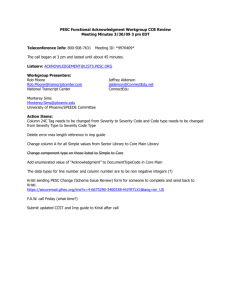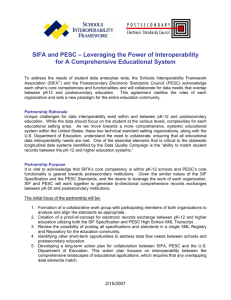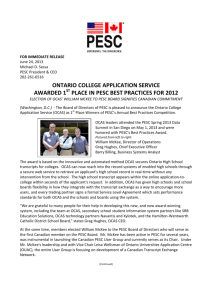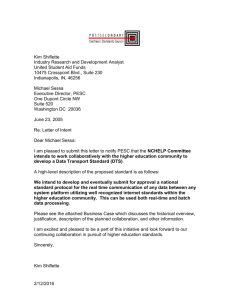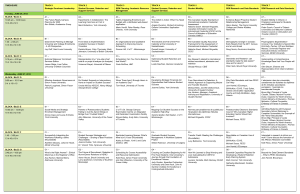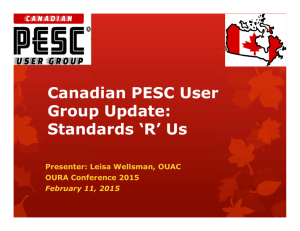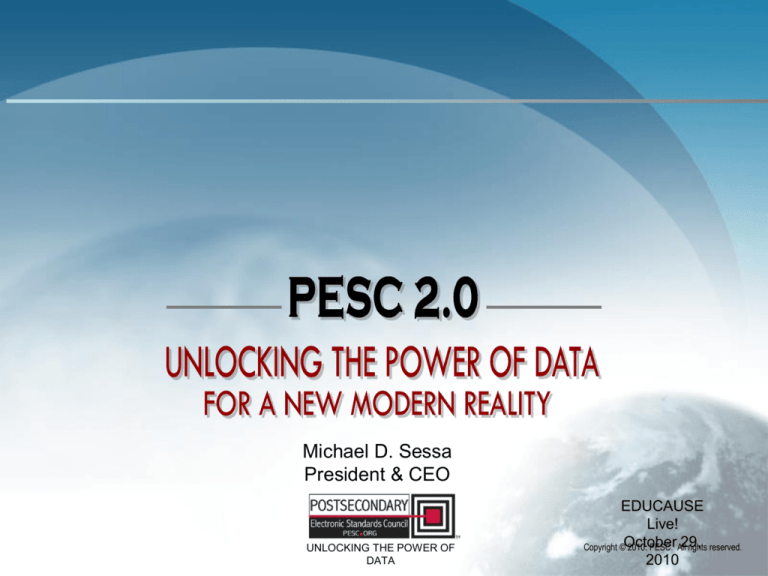
Michael D. Sessa
President & CEO
UNLOCKING THE POWER OF
DATA
EDUCAUSE
Live!
29,
Copyright ©October
2010. PESC. All
rights reserved.
2010
THE BASICS:
How standards are set:
2
Government mandate (i.e. legislation and/or regulation)
Informally or defacto when a single product/service gains wide market use
Formally through cooperation, collaboration, study, and approval by a
designated group
National Technology Transfer & Advancement Act
“...all Federal agencies and departments shall use technical
standards that are developed or adopted by voluntary consensus
standards bodies, using such technical standards as a means to
carry out policy objectives or activities determined by the
agencies and departments.”
“...Federal agencies and departments shall consult with voluntary,
private sector, consensus standards bodies and
shall...participate with such bodies in the development of
technical standards.”
Section 12 (d) (1-2)
3
Office of Management & Budget Circular No. A-119
What are the goals of the government in using
voluntary consensus standards?
Eliminate the cost to the Government of developing its own standards and
decrease the costs of goods procured and the burden of complying with
agency regulation.
Provide incentives and opportunities to establish standards that serve national
needs.
Encourage long-term growth for U.S. enterprises and promote efficiency and
economic competition through harmonization of standards.
Further the policy of reliance upon the private sector to supply
Government needs for goods and services.
4
Section 143 of the Higher Education Act of 1965
“In order to improve the efficiency and effectiveness of the student aid delivery
system, the Secretary and the COO shall encourage and participate in the
establishment of voluntary consensus standards and requirements for the
electronic transmission of information necessary for the administration of
programs under title IV.”
The COO shall participate in the activities of standards setting organizations...
The COO shall encourage higher education groups seeking to develop
common forms, standards, and procedures...to conduct these activities
within a standard setting organization.
The COO may pay necessary dues and fees associated with participation...
5
Factors Impacting Standards in Higher Education
6
US Department of Education
Federal Student Aid (FSA) - Direct Loans, FAFSA, NSLDS, etc.
National Center for Education Statistics (NCES) - IPEDS Data Collection
Planning, Evaluation & Policy Development (OPEPD) - Pending
Other Federal Agencies
NSF, NIH, DHS, HHS, DOD, etc.
Coordination: System to System, Public to Private, PK12, International, etc.
Shift to State-Based Grants: Federal and Foundation
Market Factors: Cost, Efficiency, Data Quality, Blended Paper/Electronic
Services, Infrastructure, Competition, Transfer
CASE STUDIES
7
GOAL: Use identical XML Architecture & Data Modeling Guidelines
2001
2002
2003
2004
2005
2006
2007
2008
2009
Financial Aid
CommonLine 4
CommonLine 5
?
Phases out pre CL 4
?
Campus-Based
FAFSA/ISIR
Servicing
IPEDS
8
Phased out
Phased out
Required
COD - Direct Lending
Phased out
Optional
PELL
Early Adopters
Common Record
GOAL: Use identical XML Architecture & Data Modeling Guidelines
Registrar/
Admissions
Transcripts
EDI
College – XML
High School – XML
Admission Application
EDI
XML
Test Score
EDI
XML
Course Inventory
EDI
XML
9
1990 - 2000
2001
2002
2003
2004
2005
2006
2007
2008
2009
Many states are setting up their own centralized hubs to manage data
exchange within their own respective states. Many too are including high
schools and private, independent colleges and universities as spokes in
the network – a truly robust and complete state-based solution. This
scenario applies to college or university systems as well.
Hub
10
Spokes – One state
college or university that
needs to send data to
another sends it through
the central state hub.
How is data communicated when a student transfers out of one state and into
another? What about from college to college, or college to university?
What about international students?
?
11
WE KNOW THIS!
Without data standardization, expect:
12
increased cost of systems, IT, integration
increased cost in resources due to serial, redundant and customized
programming for the same data elements
slower response to customer needs
increased data mapping which jeopardizes data quality and integrity
more difficult access to data
repetitive programming if rules, regulations, or business needs change
Whiles states can set up their own hubs to manage data exchange within their
own respective states, national standards facilitate data exchange across state
lines – state to state or hub to hub. Peer to peer exchange is possible with
national standards, but a centralized method for exchanging data is needed as
well for states, regions, colleges, and universities that don’t have or want their
own hubs or don’t want a peer to peer model.
Technical
Data
Standards
13
WHAT ARE WE DOING ABOUT IT?
14
Broad exchange and transportation of data from one point to another remains
largely unaddressed in higher education
There is a significant need for a centralized hub or network that can exchange
data standards for states, colleges and universities in need
Without a service, states, colleges, and universities have to search for a
mechanism on their own or build it themselves
Leaving each entity to build mechanisms on its own is extremely expensive, will
take years, and as a result may never actually happen
PESC MISSION & VISION
Through open and transparent community participation, PESC enables
cost-effective connectivity between data systems to accelerate
performance and service, to simplify data access and research, and to
improve data quality along the higher education lifecycle.
PESC envisions national and international interoperability, that is a trustworthy, inter-connected
environment built by and between communities of interest in which data flows seamlessly from one
system to another and throughout the entire eco-system when and where needed without
compatibility barriers but in a safe, secure, reliable, and efficient manner.
While PESC promotes the implementation and usage of data exchange standards, PESC does not set
(create or establish) policies related to privacy and security. Organizations and entities using PESC
standards and services should ensure they comply with FERPA and all local, state, federal and
international rules on privacy and security as applicable.
15
OUR FOUNDING
Established in 1997 at the National Center for Higher Education and located in
Washington, D.C., the Postsecondary Electronic Standards Council (PESC) is a nonprofit, 501(c)(3) community-based, umbrella association of colleges and universities;
college and university systems; professional and commercial organizations; data,
software and service providers; non-profit organizations and associations; and state
and federal government agencies.
•
•
•
•
•
•
•
•
•
•
•
•
16
AACRAO
AASCU
ACT, Inc.
CAUSE (now Educause)
Citibank
COHEAO
College Board
Education Finance Council
Educational Testing Service
Harbinger Corporation
KPMG Peat Marwick LLP
Law School Admission Council
•
•
•
•
•
•
•
•
NACAC
NACUBO
NASFAA
National Computer Systems
NCHELP
Salie Mae Servicing Corporation
Student Loan Servicing Alliance
Systems and Computer Technology (SCT) Corporation (now
SunGard Higher Education)
• USA Group (now USA Funds)
• U.S. Department of Education
DELPHI STUDY
Benefits of approved standards for developers &
consumers:
17
increases the value of existing and future investments in IT
allows the portability of data
decreases the long-term cost of ownership for applicable software vendor
alternatives
expands choices for software vendor alternatives
Factors driving participation in a standards body:
vendor neutrality
access to a developer community and best practices
membership comprised of both end users and commercial software vendors
international presence and focus
industry-wide or horizontal orientation
open or “democratic” committee process
opportunity to direct standard specification from moment of conception
18
PESC GOALS
1. Accelerate Performance & Service
2. Reduce Cost
3. Lead Collaborative Development
4. Set /Maintain Data Standards
5. Promote Best Practices
6. Link Public & Private Sectors
7. Serve as Data Experts
19
PESC BOARD OF DIRECTORS
Bill Hollowsky, General Manager, SunGard Higher Education
Vice Chair Francisco Valines, Director of Financial Aid, Florida International University
Treasurer David Moldoff, CEO & Founder, AcademyOne, Inc.
Secretary Rick Skeel, Director of Academic Records, University of Oklahoma, Represents AACRAO
Jeffrey Alderson, Director of Development, ConnectEdu
Brian Allison, Vice President for Technology & Industry Initiatives, USA Funds,
Chair
Represents NCHELP
Russ Buyse, Vice President R & D, Transcript Solutions, Edustructures/Pearson
Judy Chappelear, Vice President of Solutions, Xap Corporation
Matthew Coombs, Senior Director of Systems Development, San Joaquin Delta
College District, Represents Kuali Foundation
Doug Falk, Chief Technology Officer, National Student Clearinghouse
Russ Judd, Vice President of Industry Relations, Great Lakes Educational Loan Services,
Represents NASLA
Michael Sessa, President & CEO, PESC
Andy Wood, Senior Director of Higher Education Product Development, Oracle Corporation
20
HIERARCHY
Board of Directors
Executive Advisory
Committee
Steering
Committee
President &
CEO
Seal of
Approval
Membership
Services
Change
Control Board
Social Media
& Networking
Task Force
Support
Resources
Technical
Advisory Board
EA2 Task
Force
Support
Resources
Support
Resources
Workgroups
Workgroups
Workgroups
Workgroups
21
EdUnify Task
Force
Attribute
Workgroup
Student Aid
Workgroup
PESC Membership
AACRAO*
AAMC
AcademyOne, Inc.
Accenture
ACE
ACT*
Avow Systems, Inc.
Board of Regents, Georgia University System
California Community Colleges
California School Information Services
Central Connecticut State University
Clayton State University
College Board*
College Source, Inc.
Common Application
Community College of the Air Force
ConnectEdu, Inc.
Datatel
Decision Academic
Docufide
Educause*
Edustructures/Pearson
ELM Resources
Emory University
eScholar
Florida International University
Florida State University
George Washington University
Georgetown University
IMS Global Learning Consortium
22
Indiana State University
Iowa State University
Jenzabar
Kaplan University
Key Bank
Kuali Foundation
Leepfrog
LSAC*
NASLA
National Student Clearinghouse
NCHELP*
NELA
Nelnet
Ohio Board of Regents
Ontario College Application Services
Oregon State University, Corvallis
Oracle
PA College of Technology
Purdue University
redLantern
SCRIP-SAFE International
San Francisco State University
SIF Association
Simon Fraser University
SmartCatalog
Southern Connecticut State University
Stanford University
SunGard Higher Education*
Texas A&M University
TG
University of California, Berkeley
University of Denver
University of Idaho
University of Illinois at Chicago
University of Illinois at Urbana Champaign
University of Illinois, Student Financial
Services and Cashier Operations
University of Lethbridge
University of Louisiana at Lafayette
University of Minnesota
University of Mississippi
University of North Carolina, Greensboro
University of Northern Iowa
University of Oklahoma
University of Oregon
University of Phoenix
University of South Florida
University of Texas at Austin
University of Virginia
US Department of Education*
US General Services Administration
USA Funds*
Washington State University
XAP Corporation
Annual Membership Dues
Non-Profit College Or University
–1 campus
$150
–< $10 million
$5,000
–2 – 10 campuses
$500
–$10 million < $100 million
$7,500
–11+ campuses
$1,000
For-Profit College Or University
–$100 million +
$10,000
Commercial Organization with Revenues
–< 1,000 students
$150
–< $1 million
$5,000
–1,000 < 10,000 students
$500
–$1 million < $10 million
$6,500
–10,000 -< 50,000 students
$1,000
–$10 million < $100 million
$13,000
–50,000+ students
$2,500
–$100 million +
$16,000
Non-Profit Association*
23
Non-Profit Organization with Revenues
$5,000
State Agency
$6,000
Bank, Lender, Or Servicer
$11,000
STANDARDS FORUM FOR EDUCATION
24
Founded August 4, 2000 by the PESC Board in response to a white paper
produced by a PESC workgroup that analyzed the emergence of XML and
recommended PESC involvement
Serves as the standards development body of PESC
“Candidates” for standards are proposed, developed, and processed by the
Standards Forum
Governed by a Steering Committee
Follows established policies and procedures for development and approval
Includes multiple Boards and Workgroups
eX tensible Markup Language
25
Designed to improve the functionality of the web by providing flexibility and
adaptability:
– customized and dynamic
– ideal for real-time transactions and messaging
– <title>Electronic Initiatives</title>
Flat files:
– fixed lengths, always with extra or redundant data
– mostly used for batch processing
– 02072003SESSAMICHAEL090120020501200300212805302003
Identifying, defining, formatting, and transmitting data from point A to point B
XML 1.0 approved by W3C 2/98
Emerged as the technology for real-time, web-based transactions
Lacked “common” or industry standards
STANDARDS DEVELOPMENT
26
Define and standardize “simple” data elements (also called “core
components”) and “complex” core components (several simple core
components grouped together)
Group core components together into business transactions
Develop implementation guides for reference and support
Issue candidates for public comment and approval/voting process
Populate “Core Main” data dictionary with all simple and complex core
components
Store all core components in the XML Registry & Repository for the
Education Community
POLICIES AND PROCEDURES
27
Released March 2005
Focus is on collaboration, submission, approval, & maintenance
Includes:
Process
PESC Guidelines for XML Architecture and Data Modeling
Users Guide for XML Registry and Repository for the Education Community
Adopted by FSA
XML REGISTRY & REPOSITORY FOR
THE EDUCATION COMMUNITY
28
Developed, owned, and administered by FSA
Governed by PESC
Stores PESC approved standards
Sorted alphabetically by core component, by classification/taxonomy,
by sector and by message specification
Free and open to the public w/o barriers or user name and password
ORGANIZATIONAL OVERVIEW
80 Members and Affiliates and 7 major partners
Seal of Approval Program – Optional service to ensure uniformity of implementation
Formal policies/procedures for development/architecture – Guides
development
XML Registry & Repository for the Education Community – Administered by
the US Department of Education & governed by PESC – accessibility of standards is open
& free
9 Standards Approved – High School Transcript, College Transcript, Common
Origination & Disbursement (COD), Common Record: CommonLine (CRC), Data
Transport Standard (DTS), Online Loan Counseling, Admission Application, IPEDS,
Education Test Score Reporting
5 Standards in Development – Academic e-Portfolio, Academic Progress, Course
Inventory, PDF Transcript, Recruitment & Enrollment
1 User Group – Education Record User Group for all transcript processing
2 Task Forces – E-Authentication/E-Authorization Task Force – EA2
EdUnify Task Force
29
WHERE ARE WE?
30
PESC approved financial aid XML standards implemented in every*
U.S. college and university
High School and/or College Transcripts used/implemented in 6 states
(CA, GA, IN, NC, OH, VA) and throughout Alberta and Ontario
18 states plan on implementation within 18-24 months
Data Transport Standard implemented in Alberta, a handful of colleges, and
with National Student Clearinghouse
XML College Transcript implemented by SunGard Higher Education
PESC SUPPORTS
Key policy factors in higher education:
Access of student and adult learner data into the postsecondary
environment
Affordability as institutional performance is improved and made efficient
Student Achievement as administrative barriers are eliminated allowing
students to focus on learning
Lifecycle of a student
Secondary to postsecondary
Postsecondary to postsecondary
Operational Efficiencies
Reusability of development work
Recycling of data elements
31
PESC Creates New Paradigms:
32
No single law, model, or mandate can standardize higher education in its
entirety
PESC community agrees to not compete on data exchange...that the education
network/super highway is a necessary commodity
“Coopetition” – Creation of an environment of “cooperation among competitors”
for the greater common good
Standards development is consensus-based and implementation is voluntary
Lessons learned from how the ATM network and SEVIS were launched
PESC Creates New Paradigms:
33
PESC community agrees to compete on price and service
Transparent collaboration through PESC – our cornerstone principle – a
neutral objective third party, levels the playing field and allows a trusting
environment
PESC does not benefit from the national standards agreed upon by the
education community
Ability to rely on consistent, accurate data exchange frees administrators up to
focus on the needs of students
CHALLENGES
34
Awareness of longitudinal data needs and data systems alignment along the
entire lifecycle of a student bridging PK12 and higher education (PK–20) and
into Labor/Workforce
Concentration on student achievement
Incentives to address specific employment fields with shortages (e.g. STEM –
science, technology, and math)
Real-time data exchange and inquiry
Participation in standards development process vs. indifference in process and
need for off-the-shelf standards
Mobility, changing learning patterns and transfers
INDUSTRY PARTNERS
AACRAO’s SPEEDE Committee – American Association of Collegiate
Registrars and Admissions Officers, Standardization of Postsecondary Education
Electronic Data Exchange
DQC – Data Quality Campaign
InCommon Federation
SHEEO – State Higher Education Executive Officers
SIF Association
SunGard Higher Education
US Department of Education
35
NCES – National Center for Education Statistics
FSA – Office of Federal Student Aid
Office of the Under Secretary
Outreach, Education, & Awareness
ADL – Advanced Distributed Learning
CCSSO – Council of Chief State School Officers
Educause
HR-XML
IMS Global Learning Consortium
Internet2
JISC – Joint Information Systems Committee (UK)
Kuali Foundation
LETSI – International Federation for Learning, Education, and Training Systems
Interoperability
36
OASIS – Organization for the Advancement of Structured Information Standards
Office of Planning, Evaluation, and Policy Development
RS3G – Rome Student Systems and Standards Group
PESC 2.0
37
Launch of EdUnify
Continued development of common data standards
Increased education and awareness of EA2
Publications and Communications
Services & Training
Launch of Social Media & Networking Task Force
Establishment of PESC Executive Advisory Committee
COMMON DATA STANDARDS
38
New Consortium for Common Data Standards: SHEEO, PESC, CCSSO, SIF
Association, DQC, and US Department of Education
Longitudinal Data from early childhood, through elementary and secondary, to
postsecondary and labor and workforce
Technical work supported and funded by NCES
Adoption and Implementation funded by Bill and Melinda Gates Foundation and
Michael and Susan Dell Foundation
Align PK – 20 Data Systems
PK - 12
Higher Education
SIFA – SIF Specification
SIFA Developed
39
PESC - Standards
Jointly Developed
PESC Developed
Higher Education Data Model
Physical
Plant
PESC has begun
development work in
green shaded areas.
Student
Services
40
Systems in blue and yellow
shaded areas have little, if
any, standards.
Instruction
Testing
Academic
Support
Model displays disparate
college/university systems of which most
interface with each other through
proprietary formats.
Housing
Higher
Education
Data Model
Human
Resources
Library
Financial
Aid
Business
and
Finance
Bookstore
Auxiliary
Services
41
42
BENEFITS
43
9)
Serves as a governance framework
for service- oriented architecture
10) Bridges service gaps and limited
systems capacity
1)
Simplifies integration
2)
Stabilizes demands on resources
3)
Provides significant return on investment
4)
Accelerates application development time
5)
Shortens response time to emerging
customer needs
6)
Improves data quality, service and overall
performance
13) Facilitates more efficient access to
data without compromising privacy
protections and security
safeguards
7)
Bolsters systems connectivity and
interoperability
14) Lowers the cost of systems
development and management
8)
Enables software-as-a-service and fee-forservice business models
15) Eases the burden of overwhelmed
product development cycles
11) Supplies ready-to-use, off-the-shelf
public/private services
12) Fosters community-based
collaboration as services become
commoditized, shared and re-used
EdUnify can facilitate use
of the following killer applications:
1)
2)
3)
4)
5)
Faculty Search for Expertise, Schedule, etc.
Student Search for Enrollment Status
Student Progress, Traceback Search
Teacher Traceback Search
Lookup Program and Course Learning Outcomes and
Comparability
6) Government Agency Data and Information Collection
7) Student Guidance and Advising Services
8) Applications to Accelerate Learning, Research &
Knowledge Gathering
9) Applications for Mobile, Portable or Wearable
Computer Devices
10) New Media Applications
SIGN UP FOR AN ACCOUNT at
https://www.EdUnify.PESC.org
44
45
46
47
CONTACT INFORMATION
Michael Sessa, President & CEO
Michael.Sessa@PESC.org 202-261-6516
Jennifer Kim, Membership Services Director
Jennifer.Kim@PESC.org
202-261-6514
1250 Connecticut Avenue, NW
Suite 200
Washington, D.C. 20036
www.PESC.org
48

